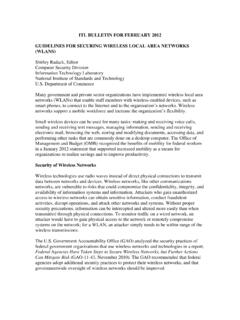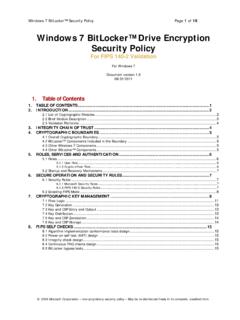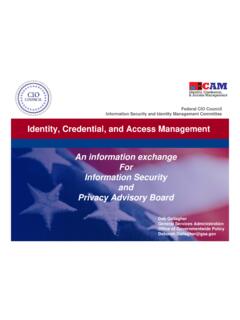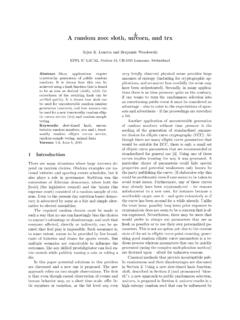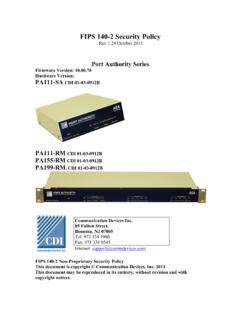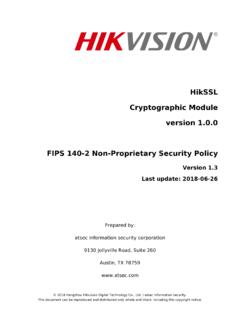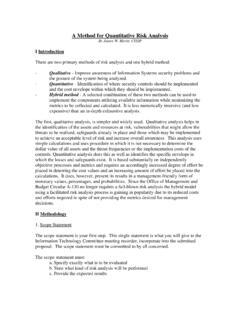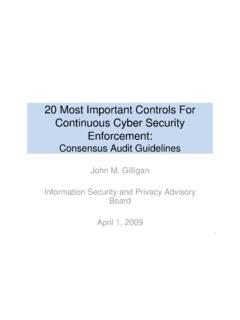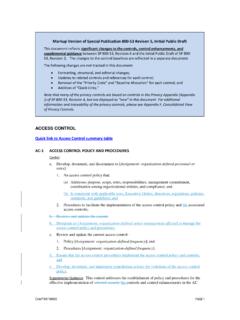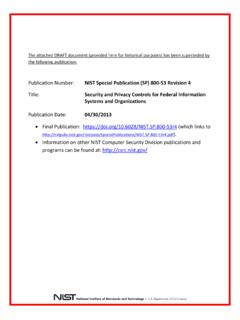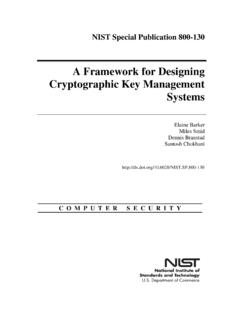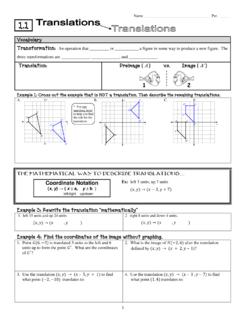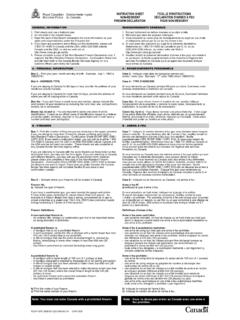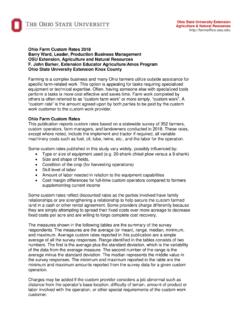Transcription of Guideline for Mapping Types of Information and Information ...
1 Guideline for Mapping Types of Information and Information Systems to Security Categorization Levels SP 800-60. AP-2/03 -1. FISMA Legislation Overview (Public Law 107-347). Framework for ensuring effectiveness of Federal Information security controls Government-wide management and oversight of risks including coordination of Information security efforts Development and maintenance of minimum controls Mechanism for improved oversight of Federal agency Information security programs. Acknowledges that commercially developed products offer effective Information security solutions Recognizes that selection of specific security solutions should be left to individual agencies AP-2/03 -1.
2 NIST FISMA Tasks In accordance with the provisions of FISMA, the National Institute of Standards and Technology has been tasked to develop: Standards to be used by Federal agencies to categorize Information and Information systems based on the objectives of providing appropriate levels of Information security according to a range of risk levels Guideline for identification of national security Information and Information systems Guidelines recommending the Types of Information and Information systems to be included in each category Minimum Information security requirements (management, operational, and technical security controls)
3 For Information and Information systems in each such category AP-2/03 -1. Categorization Standards Develop standards to be used by Federal agencies to categorize Information and Information systems based on the objectives of providing appropriate levels of Information security according to a range of risk levels . NIST Response: Federal Information Processing Standards (FIPS) Publication 199, Standards for Security Categorization of Federal Information and Information Systems. Final Publication NLT December 2003.
4 AP-2/03 -1. Identification of National Security Information and Information Systems Develop in conjunction with the Department of Defense, including the National Security Agency, guidelines for identifying an Information system as a national security system NIST Response: NIST Special Publication 800-59, Guideline for Identifying an Information System as a National Security System . AP-2/03 -1. Mapping Guidelines Develop guidelines recommending the Types of Information and Information systems to be included in each category described in FIPS 199.
5 NIST Response: Special Publication 800-60, Guide for Mapping Types of Federal Information and Information Systems to Security Categorization Levels . Final Publication NLT June 2004. AP-2/03 -1. Taxonomy Workshop Some general findings and comments: + Data/ Information sensitivity is dependent on context. + Data sensitivity and Information system sensitivity must be analyzed independently. + The context of data/ Information can be segmented into administrative activities common to all agencies and the mission-specific activities of a given agency.
6 + We need a standard process for determining the sensitivity of Information we collect and maintain as that Information relates to an agency's mission. FIPS 200 should provide a baseline process which includes sensitivity analysis, classification, and subsequent handling procedures. - A description of Information categories for administrative activities common to all agencies - A standard process for agencies to develop Information categories that are specific to their mission + The confidentiality component of the FIPS 199 draft needs to address privacy.
7 AP-2/03 -1. Minimum Security Requirements Develop minimum Information security requirements ( , management, operational, and technical security controls) for Information and Information systems in each such category . NIST Response:Federal Information Processing Standards (FIPS). Publication 200, Minimum Security Controls for Federal Information and Information Systems *. Final Publication NLT December 2005. * Special Publication 800-53, Minimum Security Controls for Federal Information and Information Systems, projected for final publication in April 2004, will provide interim guidance until completion and adoption of FIPS 200.
8 AP-2/03 -1. Draft SP 800-60 Organization 1. Overview of FIPS 199 security objectives and categorization levels 2. Overview of the process for assignment of impact levels to Information by type and general considerations relating to impact assignment 3. Guidelines for assigning mission Information impact levels 4. Impact levels by type for administrative, management, and service Information 5. Guidelines for system categorization Appendices: Glossary References Sample mission Information impact assignments Legally mandated sensitivity/criticality properties AP-2/03 -1.
9 Security Objectives and Categorization Levels AP-2/03 -1. FIPS 199. Standards for Security Categorization of Federal Information and Information Systems Applicability Applies to all unclassified Information within the Federal government and all Federal Information systems other than those Information systems designated as national security systems Agency officials to use the security categorizations described in FIPS. 199 whenever there is a Federal requirement to provide such a categorization of Information or Information systems Additional security designators may be developed and used at agency discretion.
10 AP-2/03 -1. FIPS 199. Impact Assessment Context: Agency security objectives and impacts resulting from compromise of Information and Information systems Determination: - Assumption that intentional or unintentional exploitation of particular vulnerabilities would result in loss of confidentiality, integrity, or availability - Potential impact/magnitude of harm resulting from loss would have on agency operations, assets, or individuals AP-2/03 -1. FIPS 199. Security Objectives Confidentiality: A loss of confidentiality is the unauthorized disclosure of Information .
